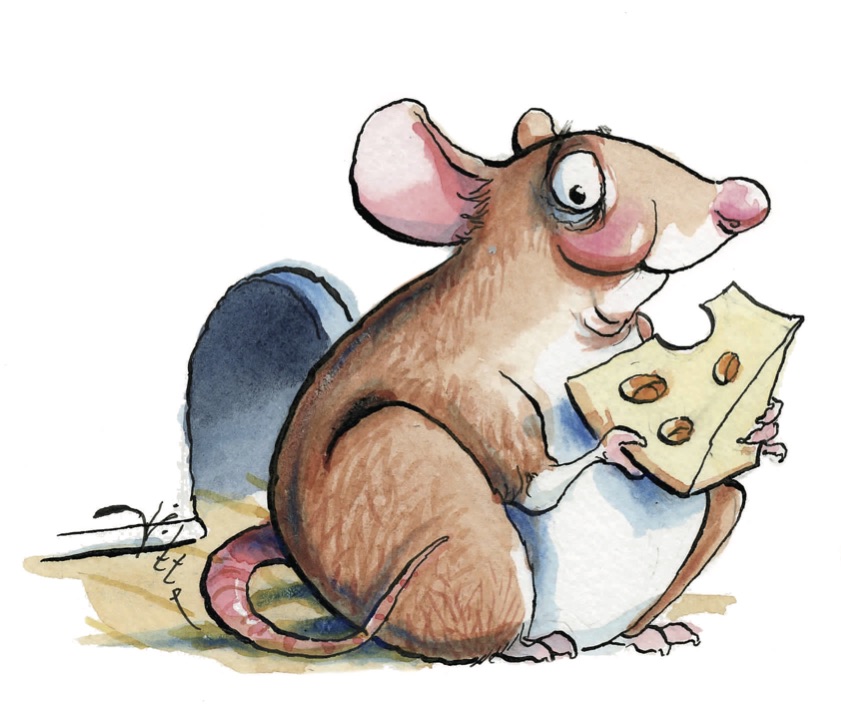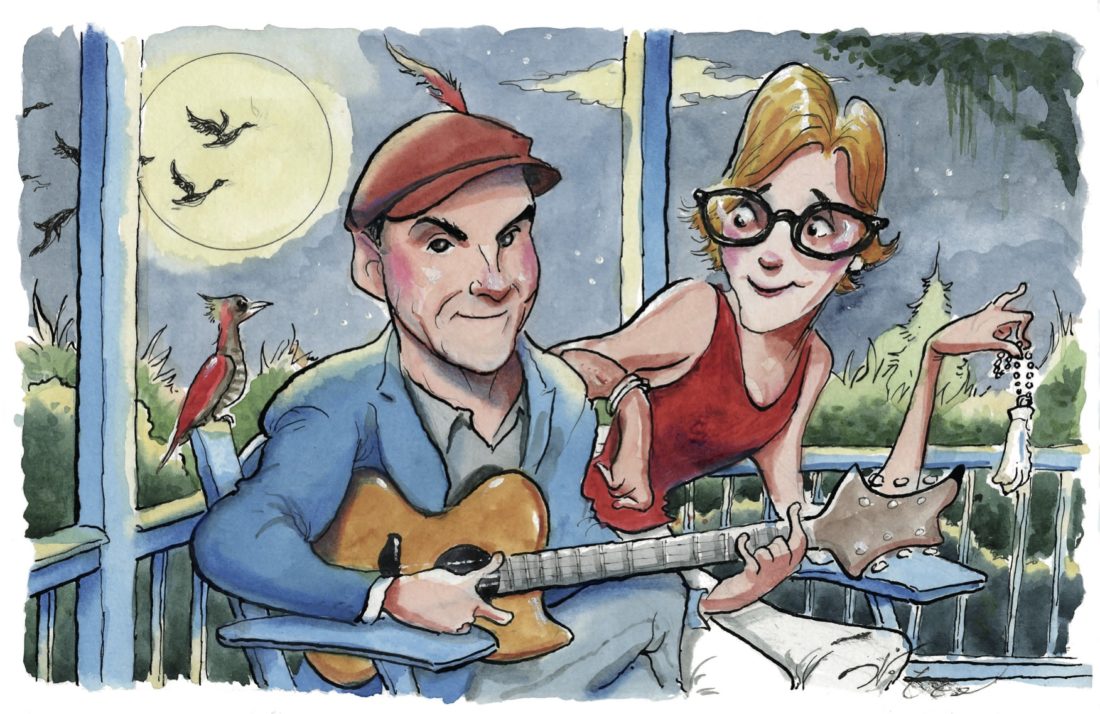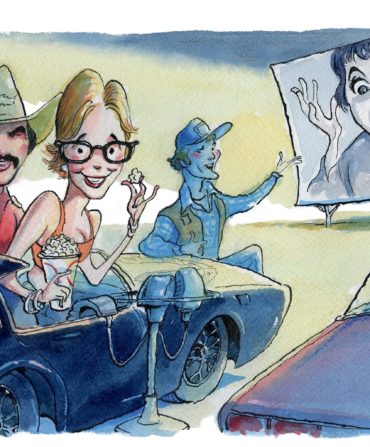James Taylor is a hardworking man. In droll Instagram videos, he splits seemingly endless piles of logs into kindling for the woodstove in his studio in the Berkshires of Western Massachusetts. Already this year, he has celebrated the fiftieth anniversary of his second album, Sweet Baby James (which means it’s been almost that long since I first fell hopelessly in love with that face, that voice surging forth from my beat-up eight-track and breaking my young heart), and by the time this column appears, he’ll have brought out a new one, American Standard, his twenty-ninth. In January, Amazon released the Audible book Break Shot, which describes the first twenty-one years of his existence, including his oft-harrowing family life and struggles with addiction, in moving and extraordinarily articulate detail. (Says the project’s producer, Bill Flanagan: “He’s one of the only rock stars you’ll ever meet who speaks in full paragraphs.”) In it, he describes how his mother, Trudy, never got over the trauma of being uprooted from the New England seaside where she grew up and plopped down in civil rights–era North Carolina. She was deathly afraid her five children would grow up to be “hillbillies” and took solace in the fact that they did not speak with obvious Southern accents. And yet.
Taylor himself all but credits his career to his idyllic early childhood in the South (the family wouldn’t reach its breaking point until a few years later), shooting BB guns and building forts with his four siblings on their isolated creek-side spread near Chapel Hill, where his father, Ike, was the dean of the University of North Carolina medical school. “If I had not had all those free days to let my imagination roam, I’m not sure I’d be a songwriter.”
A songwriter he is, of course, one of our very best, but he is also a fine singer and superlative stylist, up there with or surpassing (don’t shoot me) Frank Sinatra and Ella Fitzgerald. His ability to infuse songs that are part of the lexicon with something else, something ineffable, is what makes American Standard so damn good. But decades before he tackled “Ol’ Man River” and “The Nearness of You,” he was doing the same with beloved Southern classics like “Oh! Susanna” and “Mockingbird.” More than that, though, he preserves a particular way Southerners express themselves that I fear we are fast losing. I don’t mean the cornpone flimflam Bill Clinton whipped out whenever he got in trouble or strived to seem “authentic”: cartoonish expressions about hogs and dogs and wood ticks and turtles on fence posts. I mean the poetic, subtle, but unmistakably Southern rhythm and dialect that so often creep into a James Taylor phrase or sometimes an entire song.
There’s the occasional “y’all” (“One Man Parade”) as well as the odd expression or sobriquet (“natural born fool,” “Mama Roo” and “Lou Mama Lou,” “up and gone,” “pretty as homemade sin”). One of my favorite tunes is the infectious “Sweet Potato Pie,” which, not surprisingly, he recorded as a duet with Ray Charles, whom some have erroneously identified as its writer. I can’t tell you how much I love the fact that Anna Davis, my mother’s brilliant African American nurse from Nashville, opened every letter she wrote to Mama with “Dearest Sweet Potato Pie” until the day she died, well into her nineties. Taylor has written whole songs about pigs (“Mona”) and dogs (“Sunny Skies”). His late older brother, Alex, introduced him to stock car races, moonshine, and, most important, soul: Ray, Wilson Pickett, Percy Sledge, Sam Cooke. His close friend and collaborator Danny Kortchmar introduced him to the blues that he says “transported” him: the music of Mississippi John Hurt, Muddy Waters, Howlin’ Wolf. You can tell. Though he met the New York–born Kortchmar on Martha’s Vineyard (his mother hauled the kids up in the station wagon the minute school was out every summer), had he grown up exclusively in Massachusetts, I’m not sure we’d have songs like “Steamroller Blues,” “Chili Dog,” “Fool for You,” and “Woh, Don’t You Know.” He may be devoid of the dread drawl, but he managed to pick up plenty.
Trudy Taylor became a civil rights activist and was an artist herself—she’d studied voice at the New England Conservatory, helped design the family house that her son calls “a work of art,” raised sheep and spun wool on a loom. Like a lot of privileged white Southerners of the era, the Taylor kids were exposed to a lot of culture—museums and Broadway musicals on trips to Manhattan, their parents’ sophisticated American record collection that included the soundtrack to Oklahoma! and Aaron Copland’s “Appalachian Spring,” which Taylor says he absorbed in his bones. There is no question Taylor was at least partially “raised up” Southern (he has a song called “Raised Up Family” about that very thing), and the roots of his father’s rather gothic North Carolina family reach back generations. But in the end, he is quintessentially American, singing the songs of our collective soul in his clear, precise, vibrato-less voice. On Covers, he does a number by another great American songwriter, Jimmy Webb. I defy anyone who has heard him hold the notes toward the end of “Wichita Lineman” not to drop to his or her knees. Songs, phrases, even notes, can be little miracles, and miracles are everywhere in Taylor’s music. He supplies constant reminders of the beauty and grace that exist all around us, even when he’s singing about the most gut-wrenching stuff. Always too, there is the generosity. In Break Shot he says, “The initial motivation for writing a song may be some personal experience but if it doesn’t speak to other people, if it doesn’t offer solace or entertainment or identification or make you want to…hum along, it’s going to fail as a song. The success of an artist is not measured by how much he makes himself feel. His success is how much he makes other people feel.” He may have written “You Can Close Your Eyes” with Joni Mitchell more than four decades ago, but when we buried my brother Crews last summer, two of my closest friends sang it and it was perfect. (It also almost killed us, until another friend carried us off with his trombone.)
Taylor’s “Carolina in My Mind” has become an anthem of sorts for generations of Southerners, and I smile every time I hear the line “peace and quiet and dogs that bite” (he occasionally subs “peace and quiet” for “geese in flight”). Sometimes, live, he pronounces “quiet” as “quite,” a rhyming tactic that reminds me of the country folks with whom I grew up. As a transitional tactic of my own (!), I will also single out the lines “The signs that might be omens say I’m going, going…” I’ve been thinking a lot about both signs and omens of late. (Taylor does too, apparently—see “Home by Another Way.”) My own nurse and chief childhood protector, Coatee Jones, was never without a rabbit’s foot in her purse. She had a .22 in there as well—she learned early on to hedge her bets—and while she never let me touch the gun, I rubbed the hell out of that lucky foot. Not long ago, a dear friend, knowing I was in need of a talisman and not just a little good karma, gave me a rabbit’s foot key chain just like the one I’d been so fascinated by. I carried it with me everywhere until one day I stepped on something sharp and realized that my trusty beagle, Henry, motivated by the unstoppable forces of DNA, had eaten the whole thing, leaving only the tiny metal cap and ball bearing chain. My New Orleans neighbor, upon hearing this news, told me about a Sufi mystic who set up camp on the sidewalk in front of the house where he once lived in Khartoum. The holy man’s chief job was to pray constantly for the minister of finance so as to increase his barakas, or blessings, but as a sideline he wrote bits of Koranic verse on slips of paper. The passersby he sold them to dipped them into glasses of water, dissolving the ink, so they could literally drink the holy scripture. This delightful anecdote only confirmed what I already knew: Henry was indeed my good-luck charm.
Since Henry is also my constant companion, I had no need to acquire another rabbit’s foot, but I collect feathers and nests, hold in my hand a heavy silver heart given to me by a dear friend and then-suitor in London decades ago, and keep a carved wooden rabbit given to me by my lifelong best friend by my bed alongside a silver one of my mother’s. I still have the Kennedy half-dollars that Coatee gave me for my childhood birthdays; I stick the four-leaf clovers for which I am forever on the lookout inside the pages of my Book of Common Prayer as well as this magazine’s Good Dog book, which is sort of the same thing. Most felicitously, on New Year’s Day this year, my most spiritual friend, Courtney Cowart, also a collector of feathers (they find her, she insists), gave me a bright yellow-and-black specimen she’d discovered in the backyard of the house I recently completed in the Mississippi Delta. (Like James Taylor, I went often in my mind to the Delta, where I spent my own free-roaming childhood, until last year when I finally came home, at least part-time, for real.)
We’d never seen a feather like it, but it was so exotic we knew it must be important. I immediately called Giles Kelly, son of the same friend who gave me the wooden bunny. He’d just graduated with honors from the wildlife and forestry program at Mississippi State; now he does the Lord’s work for Wildlife Mississippi, a conservation nonprofit my father and Giles’s grandfather helped found. He got right back to me: The feather belonged to a yellow-shafted flicker, a woodpecker that sticks around the eastern United States. A beautiful bird with a fawn-colored head marked by a red stripe, it has a speckled body, but the undersides of its wings are the glorious yellow that caught Courtney’s eye. It is also the state bird of Alabama, where it is known as a “yellowhammer,” a term given the state’s Confederate soldiers due to the yellow cloth at their sleeves and coattails. We chose to ignore that ignominious piece of bird baggage and concentrate instead on the far more exciting news that the feathers of these particular flickers are believed to bring good luck and healing. Further, unlike that of pileated woodpeckers, the flickers’ pleasing call is a sustained laugh—kikiki—and they are proficient and steady drummers, playing their tunes on dead limbs and wooden houses. I swear I thought someone was knocking on my door before dawn the other day, and then I realized it was probably my new friend the bird.

Of course, it could have been the coons or the coyotes or the enormous possum who resides in the hood. This was once a primeval forest, after all, and the critters still think they own the place, which is actually fine with me, as long as they are furry or feathered. I’ve even readjusted my thinking about rats, now that I’ve found out I am one. This year, 2020, is the Year of the Rat according to the Chinese lunar calendar, and it is my sign. The rat also is the first sign of the Chinese zodiac, due to its quick thinking in winning the competition held by the Jade Emperor to decide the order of the animals—the wily creature hitched a ride on the back of an ox and jumped off just before the ox crossed the finish line, beating him to it. In addition to an obviously tricky nature, people born under the sign of the rat are said to be inventive, charming, and shrewd. George Washington and T. S. Eliot were both rats, so I’ll take it.
Best of all, the rat played the flute while on the ox’s back. Given that I’ve got a veritable posse of drummers currently in my yard, we have the beginnings of a band. I really think my man James should come visit. He could bring Jimmy Johnson on bass and Lou Marini on sax to round things out. I’ll be the one dancing with the yellow feathers in my hair.








